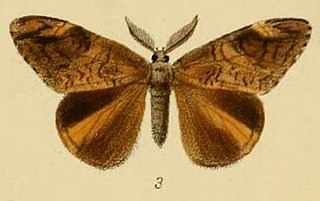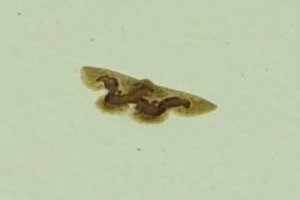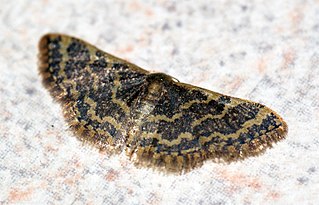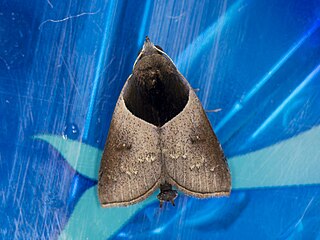Hypenagonia is a genus of moths of the family Erebidae first described by George Hampson in 1893. The adult moths have pale brown wings with a dark band across each wing. The wingspan of these moths is about 1 centimeter.
Stenhypena is a genus of moths of the family Erebidae erected by George Hampson in 1895. The type species was first found in Sri Lanka.

Aroa is a genus of moths in the subfamily Lymantriinae first described by Francis Walker in 1855. Species are distributed in South Africa, China, throughout India, Sri Lanka, Myanmar, and Java.
Gnamptopteryx is a monotypic moth genus in the family Geometridae erected by George Hampson in 1893. Its only species, Gnamptopteryx perficita, was first described by Francis Walker in 1858. It is found in India, Sri Lanka, and Taiwan.

Plutodes is a genus of moths in the family Geometridae erected by Achille Guenée in 1857.

Sauris is a genus of moths in the family Geometridae erected by Achille Guenée in 1857.
Chloroclystis atroviridis is a moth in the family Geometridae. It was described by William Warren in 1893. It is found in India and Sri Lanka.
Gymnoscelis tibialis is a moth in the family Geometridae. It was described by Frederic Moore in 1887. It is found in Sri Lanka and on Java.
Epiplema albida is a species of moth of the family Uraniidae. It was described by George Hampson in 1895. It is found in India, and Sri Lanka.

Dunira punctimargo is a moth of the family Noctuidae first described by George Hampson in 1893. It is found in Sri Lanka and Taiwan.
Heterostegane rectifascia is a moth of the family Geometridae first described by George Hampson in 1892. It is found in Sri Lanka.

Idaea gemmaria is a moth of the family Geometridae first described by George Hampson in 1896. It is found in Sri Lanka.
Idaea lineata is a moth of the family Geometridae first described by George Hampson in 1893. It is found in Sri Lanka.

Idaea micra is a moth of the family Geometridae first described by George Hampson in 1893. It is found in Asia, including Sri Lanka.

Idaea purpurea is a moth of the family Geometridae first described by George Hampson in 1891. It is found in India, Sri Lanka, Taiwan, the Andaman Islands, Peninsular Malaysia and Borneo.
Petelia immaculata is a moth of the family Geometridae first described by George Hampson in 1893. It is found in India and Sri Lanka.
Plutodes transmutata is a moth of the family Geometridae first described by Francis Walker in 1861. It is found in India, Nepal and probably in Sri Lanka.
Sauris perfasciata is a moth of the family Geometridae first described by George Hampson in 1895. It is found in Sri Lanka.
Zanclognatha minoralis is a moth of the family Noctuidae first described by Francis Walker in 1866. It is found in Sri Lanka.

Acidon nigrobasis is a species of moth in the family Erebidae first described by Charles Swinhoe in 1895. It is found in India, Sri Lanka, and Borneo.






